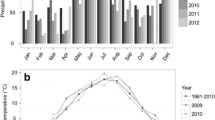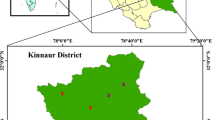Abstract
Carbon sequestration potential of agroforestry systems has attracted worldwide attention following the recognition of agroforestry as a greenhouse gas mitigation strategy. However, little is known about carbon stocks in poplar–maize intercropping systems in arid regions of China. This study was conducted in the temperate desert region of northwestern China, a region with large area of poplar–maize intercropping systems. The objective of this study was to assess biomass production and carbon stock under three poplar–maize intercropping systems (configuration A, 177 trees ha−1; configuration B, 231 trees ha−1; and configuration C, 269 trees ha−1). We observed a significant difference in the carbon stock of poplar trees between the three configurations, with the highest value of 36.46 t ha−1 in configuration C. The highest carbon stock of maize was achieved in configuration B, which was significantly higher than configuration A. The grain yield was highest in configuration A, but there was no significant difference from the other two configurations. In the soil system (0–100 cm depth), the total carbon stock was highest in configuration C (77.37 t ha−1). The results of this study suggest that configuration C is the optimum agroforestry system in terms of both economic benefits and carbon sequestration.




Similar content being viewed by others
References
Albrecht A, Kandji ST (2003) Carbon sequestration in tropical agroforestry systems. Agric Ecosyst Environ 99:15–27
Albrecht A, Serigne TK (2003) Carbon sequestration in tropical agroforestry systems. Agric Ecosyst Environ 99:15–27
Alegre J, Krishnamurthy L, Callo-Concha D (2004) Carbon sequestration by amazonian agroforestry systems. In: Proceedings of the first world congress of agroforestry-book of abstracts. University of Florida, Institute of Food, Agricultural Sciences, Orlando
Bao SD (2000) Soil and agricultural chemistry analysis, 3rd edn. China Agriculture Press, Beijing
de Jong BHJ, Montoya-Gomez G, Nelson K, Soto-Pinto L, Taylor J, Tipper R (1995) Community forest management and carbon sequestration: a feasibility study from Chiapas, Mexico. Interciencia 20:409–416
Ding SS, Su PX (2010) Effects of tree shading on maize crop within a poplar-maize compound system in Hexi Corridor oasis, northwestern China. Agrofor Syst 8:117–129
Fang SZ, Li HL, Sun QX, Chen LB (2010) Biomass production and carbon stocks in poplar-crop intercropping systems: a case study in northwestern Jiangsu, China. Agrofor Syst 79:213–222
Henry M, Tittonell P, Manlay RJ, Bernou M, Albrecht A, Vanlauwe B (2009) Biodiversity, carbon stocks and sequestration potential in aboveground biomass in smallholder farming systems of western Kenya. Agric Ecosyst Environ 129:238–252
Intergovernmental Panel on Climate Change (2003) Good practice guidance for land use, land-use change and forestry. IGES, Kanagawa
Kaya B, Nair PKR (2001) Soil fertility and crop yields under improved fallow systems in southern Mali. Agrofor Syst 52:1–11
Li QY (2008) The research on carbon storage of populous-crop intercropping system in the Huanghuaihai plain. Master Dissertation, Henan Agricultural University, pp 1–2
Li HL (2010) Carbon storage and carbon budget of poplar-crop intercropping ecosystem in the northern Jiangsu plain agricultural areas. Doctoral Dissertation, Nanjing Forestry University, pp 21–22
Li F, Zhao W, Liu H (2013) The response of aboveground net primary productivity of desert vegetation to rainfall pulse in the temperate desert region of northwest China. PLoS ONE 8:e73003. doi:10.1371/journal.pone.0073003
Liao KT, Zhang JC, Man DQ, Yan ZZ, Li DL (2006) Analysis and evaluation of farmland shelterbelt diversity in Hexi oasis. J Soil Water Conserv 20:186–189
Nair PKR, Kumar BM, Nair VD (2009) Agroforestry as a strategy for carbon sequestration. J Plant Nutr Soil Sci 172:10–23
Oelbermann M, Voroney RP, Thevathasan NV, Gordon AM, Kass DCL, Schlonvoigt AM (2006) Soil carbon dynamics and residue stabilization in a Costa Rican and southern Canadian alley cropping system. Agrofor Syst 68:27–36
Peichl M, Thevathasan NV, Gordon AM, Huss J, Abohassan RA (2006) Carbon sequestration potentials in temperate tree-based intercropping systems, southern Ontario, Canada. Agrofor Syst 66:243–257
Schroeder P (1994) Carbon storage benefits of agroforestry systems. Agrofor Syst 27:89–97
Soto-Pinto L, Anzueto M, Mendoza J, Ferrer GJ, Jong B (2010) Carbon sequestration through agroforestry in indigenous communities of Chiapas, Mexico. Agrofor Syst 78:39–51
Takimoto A, Nair PKR, Nair VD (2008) Carbon stock and sequestration potential of traditional and improved agroforestry systems in the West African Sahel. Agric Ecosyst Environ 125:159–166
Udawatta RP, Jose S (2012) Agroforestry strategies to sequester carbon in temperate North America. Agrofor Syst 86:225–242
Verchot L, Van Noordwijk M, Kandji S, Tomich TP, Ong C, Albrecht A, Mackensen J, Bantilan C, Anupama KV, Palm CA (2007) Climate change: linking adaptation and mitigation through agroforestry. Mitig Adapt Strat Glob Change 12:901–918
Walker SM, Desanker PV (2004) The impact of land use on soil carbon in Miombo Woodlands of Malawi. For Ecol Manag 203:345–360
Acknowledgments
This work was financially supported by the National Key Basic Research Program of China (2013CB956604), the National Natural Sciences Foundation of China (31300323) and the China Postdoctoral Science Foundation Funded Project (2014M552515). The study was carried out at Linze Inland River Basin Research Station.
Author information
Authors and Affiliations
Corresponding author
Rights and permissions
About this article
Cite this article
Xie, T.T., Su, P.X., An, L.Z. et al. Carbon stocks and biomass production of three different agroforestry systems in the temperate desert region of northwestern China. Agroforest Syst 91, 239–247 (2017). https://doi.org/10.1007/s10457-016-9923-1
Received:
Accepted:
Published:
Issue Date:
DOI: https://doi.org/10.1007/s10457-016-9923-1




